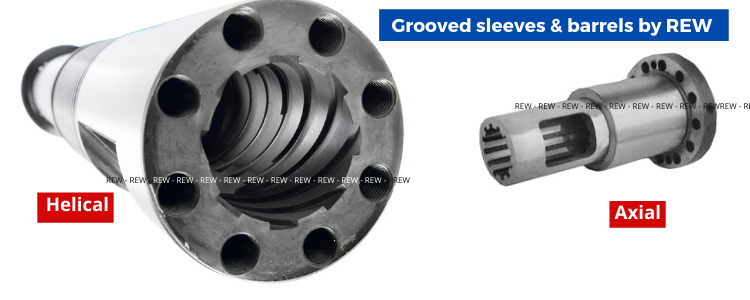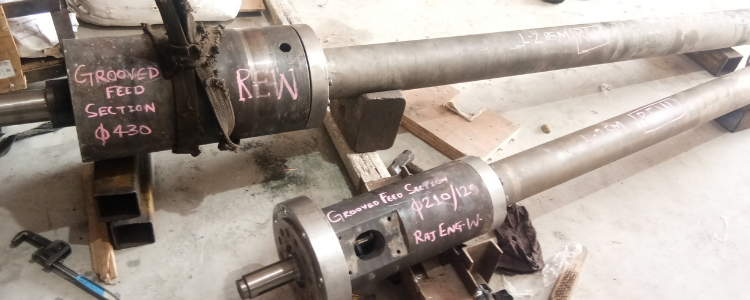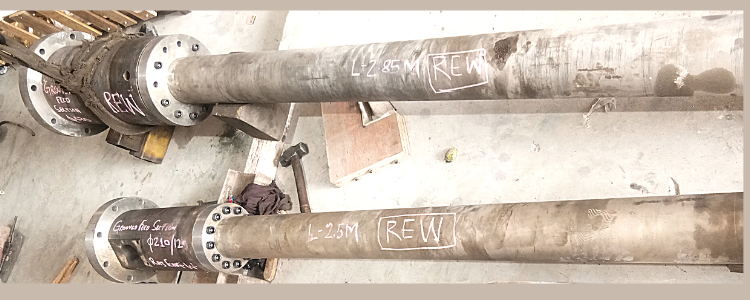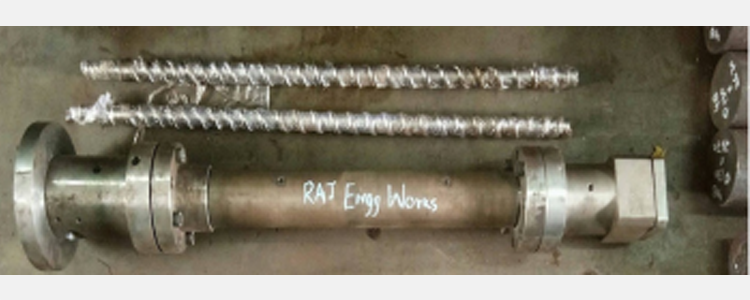Groove Feed Bush and Sleeved Barrel
Inquiry NowGrooved Feed can increase output and reduce melt temperature. But these throats are not for every application.
They have specific applications, with many polymers, grooved-feed extruders produce 20-40% higher output per rpm than the same diameter extruder with a smooth feed bore. A grooved feed section improves solids conveying and increases extruder pumping action, thereby raising output at a given extruder rpm, reducing energy put into the polymer, and lowering melt temperature.
Fig.1 - manufacturing process of grooved feed section (unfinished)Groove lengths are usually 4D or less
To prevent over-pressurization of the barrel, as Pressures exceeding 12,000 psi have been achieved at the end of the grooved section, special care must be exercised in design. That can be done modifying the design of the grooves themselves, or by designing a decompression section in the screw.
Learn More About Grooved Feeding
Pressures exceeds at the end of the grooved section, so care must be exercised in design to prevent over-pressurization of the barrel.
The grooved feed throat is intensively cooled so the material won't prematurely melt and hinder pressure development.
the pressure from the grooved feed throat transfers through the barrel, counteracting the discharge-pressure resistance. If the feed-throat pressure development exceeds the discharge pressure, the output will exceed the drag flow, resulting in further throughput gains.
Before deciding to move to a grooved feed throat, weigh the advantages against the disadvantages for your process.
The advantages of grooved feed throats:
Reduction or elimination of the effect of high head pressure, resulting in higher output.
Reduction in melt temperature at same output.
Stabilized output.
Not very sensitive to barrel temperatures.
The disadvantages of grooved-feed throats:
Proportionally more drive power required.
Performance very sensitive to particle characteristics.
Generally not suitable for most regrind due to plugging of the grooves.
Does not work on soft polymers like many TPEs due to plugging of the grooves.
Not as good for compounding additives without extensive mixing sections due to higher specific output.
Not generally suitable for powdered polymers or additives.
Can have accelerated screw/barrel wear without accurate balanced design due to higher pressures in feed section.
Can be unstable with hard polymers such as polycarbonate.
Requires higher volume of cold water for cooling.
Requires a special screw design, unlike those used for smooth bore extruders.
Pressure at the end of the grooved-feed section is often higher than at the die end, so screw performance is not sensitive to die pressure the way it is in smooth-bore extruders. Smooth-feed extruders operate against die pressures of 3000-4000 psi and must raise screw rpm to get the same output as they do at lower die pressure. The energy to pressurize the melt plus the energy from higher screw speeds on a smooth-feed extruder make operation difficult as melt temperature and pressure rise.
Where there are no advantages, neutralize grooved-feeding action by heating the grooves, thereby making grooved-feed sections nearly as versatile as smooth.
Conversely, to reduce the feeding action of the grooves and slow the pumping of materials like nylon or polycarbonate, heat (200-300 F or higher) can be applied to the grooves. This starts the resin melting, and avoids a dangerous pressure buildup at the end of the grooves
Another alternative is short grooves that extend only half a diameter into the barrel. For processes that run up to 50% regrind, short grooved-feed sections can improve feeding consistency. But short grooves won't work on HMW-HDPE. And high regrind percentages of any low-bulk-density material (10 lb/cu ft or less) will also feed poorly unless the fluff is compacted before it is added.
Pressures at the end of the grooved section can get as high as 15,000-20,000 psi. So equipment should be designed to take up to 30,000 psi, even though today's groove and screw designs try to maintain feed pressures below 10,000 psi.
Pressure at the end of the grooved-feed section is often higher than at the die end, so screw performance is not sensitive to die pressure the way it is in smooth-bore extruders. Smooth-feed extruders operate against die pressures of 3000-4000 psi and must raise screw rpm to get the same output as they do at lower die pressure. The energy to pressurize the melt plus the energy from higher screw speeds on a smooth-feed extruder make operation difficult as melt temperature and pressure rise.
Grooved-feed extruders' higher output per RPM requires a larger gear box than smooth-bore machines of similar diameter. It also takes more torque to start up or restart.
Right resins for grooves
Polyolefin are by far the most common polymers successfully processed with cooled grooved feeds.
So grooved feed is being looked at--and sometimes selected--to lower melt temperature.
Processors most likely to benefit from using grooves have dedicated operations using only one or two polyolefins at high output rates. Examples are lines running high-viscosity PE and PP for pipe, sheet, blown film, and blow molding. Materials with high melting points and higher crystallinity don't work as well on grooved-feed extruders.
Smooth feed is generally better than grooved feed when you need to process a variety of polymers, use low-bulk-density regrind, and vary regrind particle size and/or percentage. Particle size of feed materials affects groove performance, so if no control is ensured over regrind percentages or particle size, a controlling weigh hopper or a melt pump is needed to ensure constant output. Smooth-feed extruders, with relatively deep feed channels, are less affected by regrind particle size and less susceptible to fluctuating regrind percentages. More disciplined operation is therefore required for a grooved-feed set-up.
Grooved-feed extruders perform best with precolored resin. Adding color masterbatch requires a higher level of mixing from the screw and higher melt temperatures, thus offsetting some of the benefits of grooved feed.
Smooth-feed extruders also do better with higher-melt-temperature polymers like nylon, PET, polycarbonate, and fluoropolymers. If these materials are to run on a grooved-feed machine, the grooves are typically heated. This reduces feeding efficiency because it allows some melting in the grooves. Also deeper screw feed channels can be used to reduce the tendency to overfeed the extruder.
Soft, gummy resins such as TP urethanes, other elastomers, and softer metallocene polymers also have difficulties in grooves if not cooled enough. Soft pellets can smear and fill the grooves, reducing forward force and/or causing gels in film.
Vented extrusion is also not a great choice for a grooved-feed extruder, since output is usually limited by the pumping capacity of the second stage. A very efficient first stage may produce enough output to flood vents or cause poor melting at vents. Melt at the vent must be complete enough to allow evacuation (usually under vacuum) of air, moisture, and resin volatiles.
You are in product section page no.10
Previous Product
© 2023 Raj Engineering Works
This website is under artificial intelligence supervision and copying data, keywords from this site is a punishable offence.





